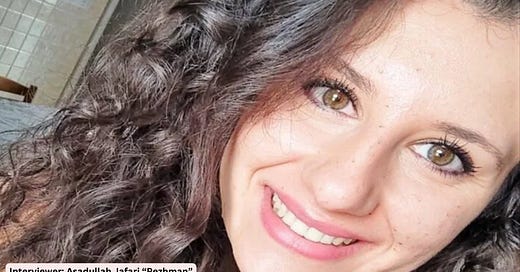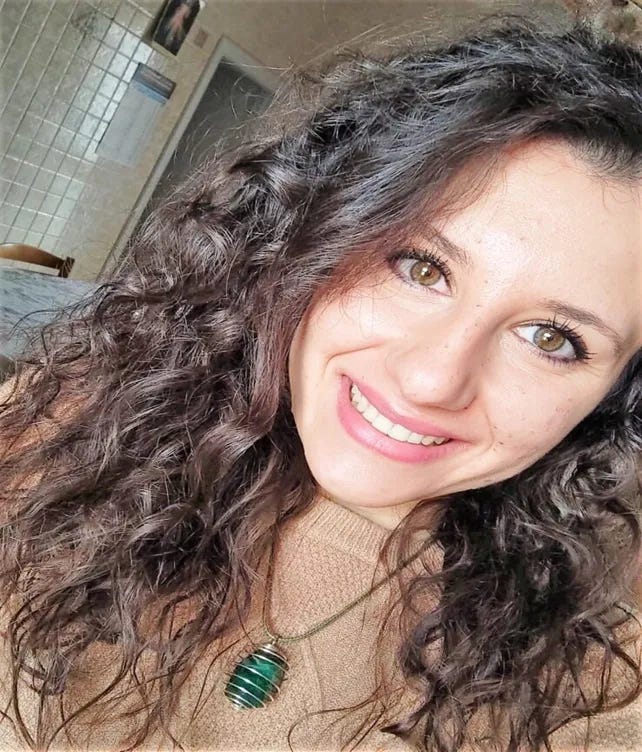In the Realm of Poetry and Translation—An Interview with Anna Ferriero
Of course! Emily Bronte’s Tempestose Peaks (it sits on my nightstand like a Holy Bible). I read a lot of Persian literature, like Rumi and Avicenna, and I also read THE BOOK OF HEALING by Avicenna
Interviewer: Asadullah Jafari “Pezhman”
In the realm of literature, poetry, and translation are two intricately intertwined facets of art. Poetry, as a universal language, conveys human emotions and thoughts in a way that penetrates the hearts and minds of its audience. On the other hand, translation acts as a bridge, transferring these emotions and thoughts from one language to another, bringing cultures closer together. In this context, poets and translators play a crucial role in strengthening and expanding these cultural connections.
Ms. Anna Ferriero, a distinguished Italian poetess and translator, is one such artist who has carved out a special place in the World of literature with her creative works in both poetry and translation. With her expertise in translation, she has collaborated with numerous national and international literary magazines, served as a literary judge for translated works, and simultaneously offered a fresh and unique perspective on life and humanity through her poetry. In this interview, we had the opportunity to talk with Ms. Ferriero about her views, experiences, and works in both poetry and translation.
Mohajir Times: Thank you so much for your time, Ms. Ferriero. Please introduce yourself. Where were you born, where are you residing, what is your educational background, and what is your current profession?
Ferriero: Thank you for this interview. It is a great honor for me. I am Anna Ferriero, a poetess, writer, and translator. I was born in Italy in Pollena Trocchia. I attended classical high school and learned English language training there. I have a Bachelor’s Degree from Orientale University in Naples, and I studied Spanish and Portuguese.
As of 2019, I am a member of WNWU (World Union of National Writers of Kazakhstan). In 2014, I certified in English B1 at La Verde Isola del Spaere (Cercola). In 2024, I participated in the XI Edition—Literary Translation Course for Publishing at Cervantes in Naples. In 2015, I became a Reiki Master with Canadian teacher Liliane Pottle. From 2016 to 2017, I attended psychology and psychotherapy seminars at SIPI Integrazioni. In 2022, I obtained an EIPASS 7 MODULE USER, and I am also an IFCH member. In 2020, I attended seminars on the Montessori Method and competitions at IGEA in kindergarten and primary school. In 2024, I worked as a bookseller at Pacifico Libri (CE) for one summer season. My published works are as follows:
The second mixed publication, OMBRE ALLO SPECCHIO (Vitale Edizioni), published in 2016
The second poetry collection, PUNTO, Oltre Horizonte (Albatross), was published in 2016
The first mixed LA CRIPTA DEI DESDIERI (Vitale Edizioni) published in 2016
The first poetry collection, MAGIC OF LOVE (LER), was published in 2015
Mohajir Times: Could you tell me how you started your journey in poetry and translation and what attracted you to these two fields?
Ferriero: Poetry has always been a part of my life. I grew up with Jane Austen’s verses and between the pages of Emily Brontë’s novel Wuthering Heights (my mother had a visceral love for it!). As I read these verses, I stumbled into this World and covered the poem Daffodils by W. Wordsworth (the Anglo-Saxon figure of Giacomo Leopardi with his broom, which I place alongside daffodils).
So, the link with translation arose somewhat spontaneously: “How would this verse be translated into Italian in my mother tongue? or ‘How can it be translated backward? Is there any synonym? What if that poetess reasoned in Italian and not in English?” there. All these questions and all these doubts brought me closer to the World of translation.
Mohajir Times: Do you work primarily in poetry or translate as well? Which languages do you translate, and do you initially write mainly in Italian or in English?
Ferriero: I am now working on poetry and translation simultaneously. I think and believe that poetry and translation should go together. In the beginning, I wrote mainly from Italian and translated from Italian into English—from Italian into Spanish. Today, I try to think in the target language (LA), English or Spanish, to come up with poetic concepts that are as original as possible so as not to lose the true meaning of LA.
Mohajir Times: When did you become interested in poetry and literature, and was there a specific person or event that shaped this interest?
Ferriero: I was first introduced to English literature, and I have always loved the English-speaking World. Thanks to my mother. When I was six, she showed me Wuthering Heights by Emily Bronte, and I immediately fell in love with Gothic art. My mum loved the poems of Giacomo Leopardi, and she often read “The Broom and A Silvia” to me. So, I can tell you that my mother was and is a very important person for my poetic and literary education.
Mohajir Times: Which poets from other languages have influenced you the most in poetry literature, and why?
Ferriero: Mainly all the poets of English Romanticism, in particular Jane Austen, the Brontë sisters, George Eliot, and Elizabeth Gaskell, but also Italian poets such as Giacomo Leopardi, Ugo Foscolo, Gabriele D’Annunzio and Giovanni Pascoli. Sometimes later, I discovered F. G. Lorca, Cvetaeva, F. Pessoa, and Khalil Gibran.
Mohajir Times: What themes and subjects do your poems usually encompass? Is there a particular theme that always inspires you and your audience?
Ferriero: Obviously, love and communion between people. Simple Nature through its complicity and the Greek myth. (I am Italian and Western and cannot help but feel part of this part of the World.)
Mohajir Times: What is the main source of inspiration for your poetry? Have specific moments or people in your life influenced your writing? What are the main themes in your poetry, and why are you drawn to them?
Ferriero: Nature and Greek myth are the two ever-present points in my poetry. I believe that poetry has Greek roots, and the exaltation of Nature represents that element that can explain everything: from everyday life to states of mind, to the changing of the seasons, to traveling, and so on.
Mohajir Times: As a poetess and translator, what are your main challenges in writing and translating?
Ferriero: The biggest challenge is to find the translation that is closest to the source language (LP), the target text (TA), and the times (e.g., el chupapiedras which is a lexical Andalusianism cannot be translated today and literally as suckers—stones because it was a game formed by a circle with a hole at the current).
Mohajir Times: In today’s World, where technology and digital media have a special place, how do you see these changes impacting poetry and translation?
Ferriero: I’ve always been in favor of social media when used correctly and at the right time. I think social media helps poetry to be known by many individuals quickly. I believe these tools break down distance, diversity, and limits among people around the globe. You come into contact with many talented poets, translators, writers, and journalists. I think that social media is a good help for translation but not a complete help (it is AI, so it can’t translate medieval sayings or gothic dishes).
Mohajir Times: In your opinion, what is the role of poetry in today’s society, and what impact can it have also, how has Italian culture and literature influenced your works?
Ferriero: Today, poetry operates very attractive exhibitions, competitions, and slams. Whether online or in-person, poetry unites, knows, and embraces peoples, countries, and cultures. The last exhibition of the Jewish Poet Iris Calif, “BUTTERFLIES OF PEACE,” was a wonderful event with the participation of two poets, among whom also me. 21 poets, accompanied by Israeli painters, on the theme of love for Peace and Nature, were surrounded by the light of God.
I live on the slopes of Mount Vesuvius, a few steps from Villa Ferrigni (Villa Giacomo Leopardi), which is filled with brooms in summer. In my town, in Torre del Greco, Leopardi wrote Alla Luna and La Ginetsra and lived the last month of his life. Naples has always been the land of many poets and writers and I think I could not have been born elsewhere.
Mohajir Times: Are you also interested in the literature on other countries? If so, which countries and why?
Ferriero: Of course! I like Hispanic, English, and Russian literature (Lev Tolstoy and Nabokov), and I also like Asian literature (The Figure of Buddha).
Mohajir Times: Is there a specific book or author who has always inspired you? Also, which Persian-speaking poets or translators do you know?
Ferriero: Of course! Emily Bronte’s Tempestose Peaks (it sits on my nightstand like a Holy Bible). I read a lot of Persian literature, like Rumi and Avicenna, and I also read THE BOOK OF HEALING by Avicenna.
Mohajir Times: Based on your experience as a poetess and translator, do the cultural and linguistic differences between various languages appeal to you especially, and how do you reflect these differences in your poems and translations?
Ferriero: The beauty of translation is precisely this: finding similarities and often equals through differences (opposites attract). The charm of translated poetry is being able to transmit in the target language (LA) the same sensations and the same World as the source language (LP). The translation will never be literal and identical to the LP, but the beauty is right here.
Mohajir Times: Thank you for taking the time, dear Anna. As a final question, what advice would you give to those interested in entering the World of poetry and translation?
Ferriero: The first advice I can give is to BE CURIOUS, EXPERIMENT, TRY, AND GET INVOLVED. Don’t be afraid, but have a lot of enthusiasm. Do not delete the first poetry and translations because then, after a few years, when you reread them, you will find that you are a different person, mature, and have understood new things. Thank you for having me and also for making me share this World.







